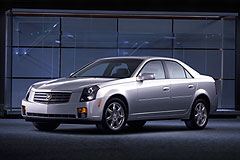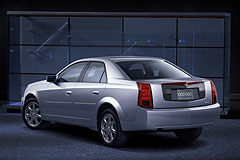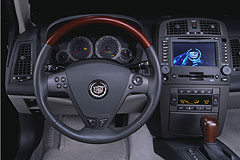
MSRP Range: $29,990 - $ 38,900
Invoice Range: $27,658 - $35,658
Price Quote
MSRP As Tested: $35,565
Vehicle Category: Mid-size Sports Sedan
Versions: CTS, Luxury, Sport
Engine Location: Front Engine
Drive Wheels: Rear-Wheel Drive
Engine As Tested: 3.2-liter, Dual Overhead Cam, V6, 220-hp at 6,000 rpm and 218 lb-ft torque at 3,400 rpm
Transmission As Tested: 5-Speed Manual, optional 5-Speed Automatic
Fuel Economy (city/hwy): 5-Speed Manual - 18/25, 5-Speed Automatic - 18/26
Standard Safety Features: Driver and Front Passenger, front and side airbags, 4 side-curtain airabags, 4-wheel disc brakes, Antilock Braking System, Traction Control, wiper-activated headlights, daytime running lights, interior emergency trunk release
Competition: 2003 Acura TL, 2003 Audi A4, 2003 BMW 3-Series, 2003 Honda Accord, 2003 Infiniti G35, 2003 Lexus ES 300, Mercedes-Benz C Class,
DANA POINT, Calif. -- We're ripping through wilderness in the Santa Margarita Mountains, following a deserted trace of crumpled pavement on La Luz Road as it twists, turns and descends into Fallbrook and, eventually, leads to the California coast at Oceanside.
The 2003 Cadillac CTS is a good vehicle for this freewheeling ride on the wild side of automotive performance. It is a world-class sports touring sedan that's well equipped for the task of tracking quickly, but adeptly, through so many winding mountain curves.
Our test car, built on a rigid platform with pliable independent suspension components pinned above each wheel, also carries a forceful aluminum engine out of England that translates all torque through a German-built Getrag five-speed manual shifter and sends it to the rear wheels in classic -- and highly predictable and controllable -- front-engine/rear-drive arrangement.
Suspension elements consist of lightweight aluminum for upper and lower control arms to reduce the vehicle's unsprung mass, which makes it stick better on the road and glide more uniformly over bumps. The design was tuned and tested repeatedly at the ultimate European proving grounds, Germany's 12.8-mile Nurburgring closed-circuit race track with 177 corners draped over unforgiving terrain in the Eifel Mountains.
Steering, through a rack and pinion device enhanced by a TRW Speedpro variable-assist power system, feels dead-on precise and quick.
Brakes, with big vented discs front and rear, counterbalance all of this car's go-power with fast-acting arrests enhanced by vacuum-boost power and electronic linkage to anti-lock (ABS) and traction control (TCS) devices, plus dynamic rear brake proportioning (DBP) and StabiliTrak, the world's best vehicle stability controller.
All of these mechanical systems, drawn from superior suppliers from around the globe, come together in this worldly new automobile to produce exacting road manners and the spirited performance of a precise German touring sedan.
Only catch is that our test car doesn't come together at one of Germany's automotive assembly plants and it also doesn't wear the badge of a German car company. Instead, the crest of Cadillac mounts on the hood.
New CTS -- Cadillac Touring Sedan -- marked as a 2003 product and rolling out of a new General Motors assembly plant in Lansing, Michigan -- represents the first rear-wheel-drive vehicle in Cadillac's fleet since 1979 and the first Cadillac to offer a manual transmission on a rear-wheel-drive platform in half a century. What's the deal?
Well, the CTS happens to be the first of a string of new vehicles now in the pipeline designed to make Cadillac cool again. For at least the first half of Cadillac's 100-year history, this automaker led the world in automotive style and innovation. During that era, in fact, the brand's image topped all others when a Cadillac signified the best.
Today, Cadillac strives to return to that favored position, as recent show-car designs with names like Evoq, Imaj and Vizon emerged as harbingers for a new age at Cadillac that promises cutting-edge designs and high-tech applications with superior performance.

Only a quick glance at the dramatic styling for new CTS signifies that this era may already be upon us. Its lines are bold and sharp but clean with unique forms marked by angular shapes and crisp edges that combine in a package that looks like no other vehicle on the road.
The aggressive face features a thick and smooth bumper lip, a prominent horizontal louver panel in modern interpretation of the Cadillac egg-crate grille that traces back to 1941 on the 60 Special Fleetwood, and piercing optics with stacked round projector-type headlamps that resemble camera lenses mounted on vertical corners.
Remember this distinctive facade, as it will also characterize all other future Cadillac's currently in design and production for the next five years.
The tail treatment on CTS is also unique with more future design cues evident, such as slick slab bumper in monochrome flanked by tall vertical taillamps, a Cadillac trademark first seen on the 1948 60 Special Fleetwood that introduced another trend defined by Cadillac -- the tail fin.
Keen lines on body panels that link face and tail also look clean but shapely with several sharp character lines stretching the length of the vehicle and wheelwells flaring around big all-season tires mounted on gleaming seven-spoke aluminum wheels.
Package size for CTS measures to mid-size proportions with the overall length held to less than five meters so CTS may compete on the global market. Cadillac plans to sell it beyond North America in Europe, Asia and the Middle East.
The new rear-wheel-drive Sigma platform underpinning CTS will also be used for future Cadillac's, such as next-year's replacement for the Seville sedan. It features an extended wheelbase and wide track with wheels set on outside corners for a sure-footed stance.

Inside a spacious cabin crafted for five passengers, the exterior theme of chiselled forms and angular features is expressed in a monochromatic treatment on CTS that looks contemporary. Analog instruments and the dashboard center stack of controls borrow the clean and compartmental look of a personal computer, as warm materials like leather-clad seats contrast against the high-tech demeanor of a cool computer.
Extensive safety measures apply, including air bags surrounding front-seat riders and stretching like curtains in concealment above front and rear side windows.
All CTS sedans destined for North America draw from a V6 engine produced by General Motors at Ellesmere Port in England. It displaces 3.2 liters and makes 220-hp at 6,000 rpm and torque numbers of 218 lb-ft at 3,400 rpm.
Standard transmission is a manual five-speed by Getrag with dual-mass flywheel added to isolate engine torque pulses and smooth the neutral gear rattle.
Also available is a sophisticated four-speed electronic automatic transmission out of a GM plant in Strasbourg, France. This shifter, which also appears in deluxe BMW products, adds driver-selection toggles for "Sport," "Winter" and "Economy" modes.
Three issues of CTS segment by tone through equipment and suspension tuning. The base edition and a version with luxury gear added skew toward the plush end of motoring while CTS with a sport package has firm suspension settings and StabiliTrak controls.
Base MSRP for CTS comes in at $29,990, but the typical transaction price is projected for $35,565.




